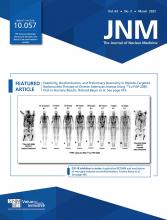TO THE EDITOR: 18F-6-fluoro-l-DOPA PET (18F-DOPA PET) scanning has been the mainstay in the diagnosis and localization of focal lesions in patients with congenital hyperinsulinism (CHI) (1). Although scan-to-lesion correlation is not completely perfect, the predictive value of 18F-DOPA PET as a clinical tool has been clinically meaningful and reliable, with sensitivity ranging from 75% to 100% (1,2), enabling significant transformation in the surgical management of focal CHI (3,4).
68Ga-NODAGA-exendin-4 PET (68Ga-exendin PET) is a new imaging modality that has potential to replace 18F-DOPA PET (5). 68Ga-exendin PET has been shown to have greater sensitivity and surgical preference in the localization of focal CHI. This exciting development has the advantage of molecular specificity in targeting glucagon-like peptide-1 receptor in pancreatic β-cells, as well as relatively low radiation (estimated at 0.77 mSV for a 1-y-old child) (6), although the short half-life (68 min) of 68Ga requires access to a local production site.
However, our enthusiasm for this new diagnostic development in CHI is tempered by a deeper examination of the data and a review of the trial design to derive divergent conclusions from those reported prematurely and optimistically by the authors (5). The prospective arm of the study recruited only 8 patients, with no justification provided on the sample size needed to demonstrate clinical benefit. In comparing 68Ga-exendin PET with 18F-DOPA PET, the order of scanning was not made explicitly clear; considering the reporting and interpretation of nonconcurrent scans (at an interval of 4–72 d) by nonmasked observers, results were undoubtedly influenced by carry-over bias. Unusually, authors added a retrospective arm to the study, citing real-world observations to support doubtful findings from prospective study data but reinforcing observational bias in the process.
Although the authors provided clear descriptions of radiotracer production and PET imaging techniques, the article ignored the need to confirm focal CHI by correlating scan results with histopathologic results on intraoperative pancreatic frozen sections. Further, the authors did not discuss location specificity or the surgical complexity in achieving complete resection of lesions to demonstrate true benefit from shifting reliance on 68Ga-exendin PET as a surgical navigational tool. Therefore, it remains unclear whether 68Ga-exendin PET offered real-world benefit to patients in either prospective or retrospective arms of the study.
The combined experience of specialist CHI centers in the United Kingdom, Germany, and the United States over 14 years has established 18F-DOPA PET as a proven clinical tool in the diagnosis of focal CHI. Notwithstanding this success, as a group we feel it is important to investigate improved imaging techniques that are more accessible, inexpensive, and reliable. However, the development of an alternative imaging modality away from 18F-DOPA PET will require convincing strength of data, which the recently published paper (5) does not provide. Clearly, this paper whets the appetite with interesting preliminary information that needs to be replicated in well-designed, prospective multicentered studies with robust patient numbers to demonstrate clear clinical benefit.
- © 2022 by the Society of Nuclear Medicine and Molecular Imaging.
REFERENCES
- Revision received July 30, 2021.
- Accepted for publication September 3, 2021.







